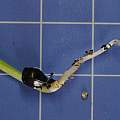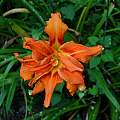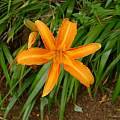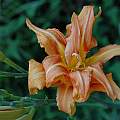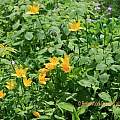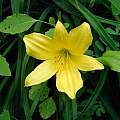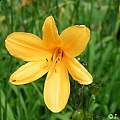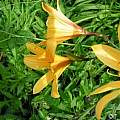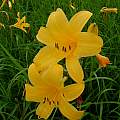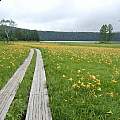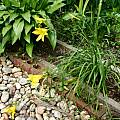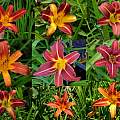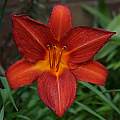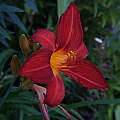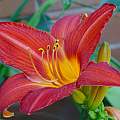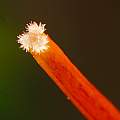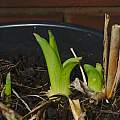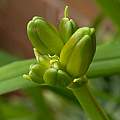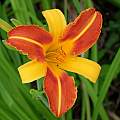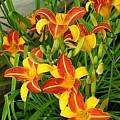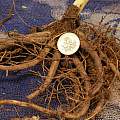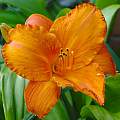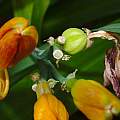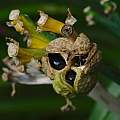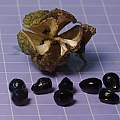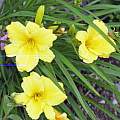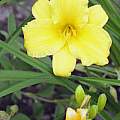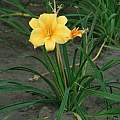Hemerocallis L. is a genus from eastern Asia and central Europe. It has been pushed around by taxonomists quite a lot, ending up in Asphodelaceae in AGP IV (details on the family page). This genus is known by the common name of day lilies since flowers only last one to several days. Most species have fibrous roots; a few are tuberous. Leaves are grasslike and basal. In warmer climates some may stay green in winter, but most are totally happy down to USDA zone 5 or lower when behaving deciduous. Hemerocallis buds and flowers are traditionally eaten in parts of Asia, both fresh and fried. While there are reports of poisoning, they seem to originate from misidentification, mixing them up with some poisonous forms of true lilies. As always: Never eat a plant you have any doubt of identification, and/or don't know if they have been treated with pesticides.
Photographs by David Pilling show seed of Hemerocallis esculenta and resulting seedling on a 10 mm grid. Seed is generally easy to germinate if it is viable (often it is not).
Hemerocallis citrina Baroni is native from Russia, to China and Japan.
Hemerocallis citrina var. vespertina (H.Hara) M.Hotta, syn. Hemerocallis vespertina, is an Asian species. The buds are used as food in China. Growing from 3 to 4 feet high, the fragrant flowers open one day and remain open overnight. Photo by Mari Kitama was taken August 2009 near the Haruna mountain (1000 m altitude).
Hemerocallis fulva (L.) L. is known as the orange, tawny, or ditch lily. It is native to Eurasia, from the Causcaus east to China, Korea, Japan and southeast Russia. Height: to about 6 ft. The first two photographs below are of the double cultivar 'Kwanso' and the variety longituba (Miq.) Maxim. and were taken by Mari Kitama in July 2004 in Japan. The last photograph is of "Kwanso'and was taken in Texas by Justin Smith.
Hemerocallis lilioasphodelus L. commonly called the 'lemon lily', syn. Hemerocallis flava (L.) L. was awarded the RHS award of garden merit. It is native from the SE. Alps, Albania, Siberia to Korea and has been introduced to many other places. Height: to about 3 ft. Photos by Judy Glattstein.
Hemerocallis middendorffii Trautv. & C.A.Mey., Amur daylily, is cultivated for its edible flowers in Asia. It is from the Russian Far East, northwest China, Korea and Japan. It is hardy (WHZ 4-9). Height to about 70 cm. Photos Janos Agoston.
Hemerocallis middendorffii var. esculenta (Koidz.) Ohwi., syn. Hemerocallis dumortieri var. esculenta (Koidz.) Kitam. is an early flowering fragrant species native to Japan. Photos by Mari Kitama taken in July 2009 at the Oze National Park (1400 m).
Hemerocallis minor Mill. was photographed in early May in the Montgomery County, Maryland, USA, zone 7 garden of Jim McKenney. It comes as a surprise to many that this elegant, early, fragrant, tiny daylily has been in European gardens since the middle of the eighteenth century. The leaning scapes and low bud count are typical - and may explain its apparent lack of popularity. It is easily grown, sets seed readily and comes true from seed. The flowers have been described as "bell shaped", and they do indeed have a fetching line. The color is a clear, singing yellow without a trace of the tawny family curse. Height: to about 45 cm.
Hybrids
This genus has been hybridized extensively and there are thousands of cultivars, expanding the flower colors to reach palest yellow (pure white is still a dream of many hybridizers) and lavender purple in the extremes. Another goal is to establish longer flowering periods and/or a second flush of flowers in fall. The two distinct groups of cultivars are the diploid, being closer to the wild forms with slender (or, in the extreme spider-ish) petals, and the tetraploid forms with wider petals and a wider range of colors. Both are incompatible, which is a main source of non viable seeds mentioned above.
A long history of hybridizing results in a complex genetic setup. The following collage shows plants grown from a single seed capsule, with 'Frans Hals' as seed parent and an unknown dark red cultivar as pollen parent. Neither the greenish throat nor the light petal rims present in some of the offspring were visible in either parent.
Hemerocallis 'Crimson Pirate' is a hybrid, introduced in 1951 by the Sass brothers of Louisville also known for hybridising Iris. Flowers are 5 inches and stems around 3 feet. Photographs taken by David Pilling in North West England; 1 - 4 were at the end of June; photo 5 shows shoots in January.
Hemerocallis 'Frans Hals' (Flory, US 1955 ) is the most famous bicolor hybrid, and as such nearly instantly recognizable. It is named for the Dutch golden age portrait painter of the same name. The diploid plants are mid size both in flower and in height. Photos by Martin Bohnet.
Hemerocallis 'Mauna Loa' is a hybrid, introduced by Roberts in 1976. Flowers are 5 inches and stems around 3 feet. Photographed by David Pilling. Photo 6 shows a seed pod and the seeds it contained on a 10 mm grid; these were the result of using pollen from Hemerocallis 'Crimson Pirate'
Hemerocallis 'Stella de Oro' is perhaps the most popular daylily cultivar. It is a smallish plant (around a foot high and spread) and hence suitable for modest size gardens. Unlike some daylilies flowering takes place over a long period. First two photos by David Pilling and the last one by Janos Agoston.

